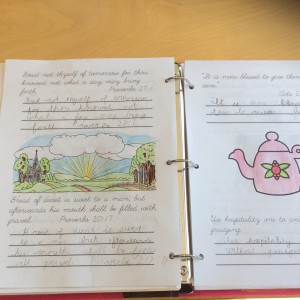I’ve already mentioned that I don’t require any creative writing at all from my young writers — no stories, poetry, or even journal writing. Instead, I wait until my writers have developed mastery of the skills required to properly express themselves on paper: quality penmanship, grammar, punctuation, spelling, and the ability to organize one’s thoughts. Apart from their more formal, mama directed learning activities, they do get creative on their own. I think that’s fantastic! I look forward to what they will create in a few years once their writing skills are developed.
Today I’m going to be talking about the first of three tools for developing these skills: copywork. Stay tuned for my upcoming posts where I will address the other two, narration and dictation, and how together they make up the foundation for good writing instruction in the early years.
This post contains affiliate links. Please see my disclosure policy for details.
What is copywork?
Copywork is the simplest of the three tools used with early writers. It is simply copying down, word for word, from a model sentence or passage. In the very beginning though, it’s even simpler than that — for your youngest learner it can be the copying of a single letter.
When it comes to copywork, less is definitely more. It is far better for your child to copy one single sentence (or letter!) beautifully than to produce a whole page of mediocre or sloppy work.
How does copywork build writing skills?
Copywork actually teaches your young learners many things! Initially, copywork teaches proper letter formation, but as your child matures and grows, they will also learn punctuation, sentence structure, spelling, grammar, and diligence by the practice.
The main idea of copywork is the imitation of quality — copying from a model of both quality penmanship and content. Copywork sources can be selections from classic literature, poetry, or scriptures.
Many literary greats themselves learned by copying great writers! While copywork can begin with children as young as kindergarten aged, it is something that is beneficial for students of all ages. I personally consider my Commonplace Book to be my own grown-up copywork.
How to use copywork in your homeschool:
- When your youngest students are starting to hold a pencil and are ready to begin writing letters, teach them to hold their pencil properly and form letters correctly. A good pencil grasp and proper letter formation will help with speed and ease later, and prevent your child from becoming frustrated and tired when writing for longer periods of time are required. As with just about anything else, it is easier to form good habits from the start that to break them later.
- Gradually increase the amount of copywork required. Have your youngest students produce a few good letters a day, then graduate to a few simple words (that are not beyond their reading ability), and eventually short sentences. Once the physical act of writing becomes easier, the selections can become longer. The key is to not require more than they are able to produce — quality above quantity!
- Choose selections based on current reading, memory work, or any other way that you desire. The work can be practical, inspiration, or even come from a prepared source or curriculum. Copywork can be done in any subject area and isn’t limited only to language arts, our current science curriculum uses copywork!
- Don’t stop using copywork! Copywork is beneficial to everyone, and doesn’t need to stop once your student becomes an excellent writer in their own right.
Here are a few resources we have used:
- Writing With Ease: The first two levels of this curriculum use copywork, narration, and dictation exclusively for building early writing skills. It’s an excellent, easy to use, open & go curriculum. If you prefer to build your own curriculum, Writing With Ease: Strong Fundamentals will walk you through how to design your own writing curriculum, using your own selections.

- NotebookingPages.com: NotebookingPages.com has many blank copywork pages to choose from, suitable for beginning writers on up to upper elementary and even adolescent students. Using the NotebookingPages Web-App you can even make your own copywork pages.
- Homeschool Copywork; A large selection of pre-made copywork pages for students of all ages. You can read my review of their membership here.

- Handwriting Without Tears: I really like how simply and effectively these workbooks teach letter formation. We’ve used the kindergarten through fourth grade books, and even the wooden letter pieces for preschoolers. I also use their Worksheet Maker to make copywork pages for my early reader — this way I can reinforce her reading lesson AND use the same writing style/font that she has used to learn to write.

- Classical Copywork: Classical Copywork offers a selection of pre-made copywork pages for all levels. They are available both in print and electronic format. The sources for copywork are scripture, catechism, McGuffey readers, and patriotic songs & sayings. You can even sign up to receive free copywork pages each week in your inbox!
Although so often we seem to emphasize the value of creativity and originality, imitation is a great way to learn! It’s how we all learned to speak after all, and it is an effective tool for learning to write well.






Wonderful insights you provided here. We used to do a lot of copywork. I realize I’ve let it slide. I appreciate this reminder and encouragement to pick it up again.
Isn’t notebooking pages the best?! I love it!
Thanks for sharing!
xoxo
NotebookingPages is a great resource!
I’ve slipped up, I had planned to use homeschool copywork more often this year.
Hmm… good reminder eh? 🙂